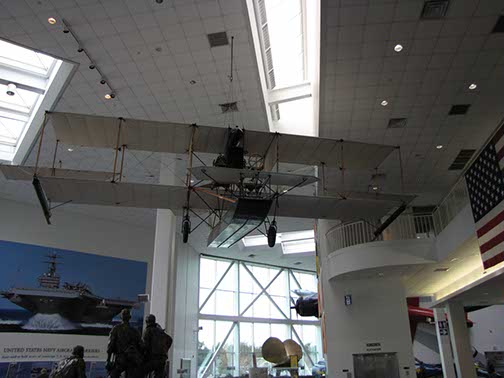NAS Pensacola
Nine photos from the Naval Air Station museum in Pensacola, Florida.
A-1 Triad
In commemoration of the fiftieth anniversary of U.S. naval aviation in 1961, the Navy joined with the Institute of Aerospace Sciences in San Diego to construct two exact replicas of the Curtiss A-1 Triad, which was the first aircraft procured by the U.S. Navy. The work of some 130 volunteers and a few employees of the Overhaul and Repair Department on board Naval Air Station (NAS) North Island, California, came to fruition in July 1961, when one of the "Triads" actually took flight over San Diego Bay. Piloted by Naval Reserve Commander Don Germeraad, Chief Engineering Test Pilot for the Convair Division of General Dynamics, the replica A-1 made multiple flightsm reaching an altitude of 100 ft. on one of them. "Now I know how the other half lived- the half century of pilots, that is," Germeraad commented after the flight. "My hat is off to the old-timers. It is really amazing what they accomplished with what they had to work with."
In addition to the flying replica, which was modified to include a more powerful horsepower engine, metal in place of bamboo in the tail boom, and laminated ash instead of spruce for spars, the Navy/IAS team also constructed one not intended to fly. Following the commemoration events in San Diego, it was donated to the Smithsonian National Air Museum (now National Air and Space Museum) while the flying replica remained in California for display in the San Diego Aerospace Museum. It was lost in a fire at the museum in 1978.
The Smithsonian's A-1 first arrived at NAS Pensacola, Florida, for display at the Naval Aviation Museum (now National Museum of Naval Aviation) in 1968. It remained on loan until 1992, at which time custody was transferred to the museum.
Notes It was upon the wings of the A-1 Triad, the U.S. Navy's first aircraft, that U.S. naval aviation took flight. Ordered in May 1911, just months after civilian pilot Eugene Ely successfully demonstrated that an aircraft could operate from a ship and aircraft manufacturer Glenn Curtiss demonstrated the feasibility of landing an aircraft alongside a ship so that it could brought aboard and put over the side by a crane, the A-1 was nicknamed Triad because with a pontoon float and retractable landing gear it could fly from both water and land. The A-1 was the airplane in which the Navy's first aviators, including Lieutenants Theodore G. Ellyson and John H. Towers, learned to fly. As would be expected of the Navy's first aircraft, the Triad was the platform for early experiments, including making the first night water landing without the benefit of landing lights, tests in airborne wireless communication, and a cross-country flight covering a distance of 112 miles in 122 minutes. It also participated in early catapult trials, though both Ellyson and the aircraft plunked into the Severn River during a firing of a compressed air catapult on 31 July 1912. It proved but one of many minor accidents encountered during the airplane's service, but the A-1's luck eventually ran out. After 285 flights and numerous rebuilds, it was damaged beyond repair in a crash on 6 October 1912.
The aircraft on display is a replica built to commemorate the Golden Anniversary of U.S. Naval Aviation in 1961.
Specifications for A-1
Manufacturer: Curtiss Aeroplane and Motor Company
Dimensions: Length: 28 ft., 7 1/8 in.; Height: 8 ft., 10 in.; Wingspan: 37 ft.
Weights: Empty: 925 lb.; Gross: 1,575 lb.
Power plant: One 75 horsepower Curtiss V-8 engine
Performance: Maximum Speed: 60 M.P.H.
